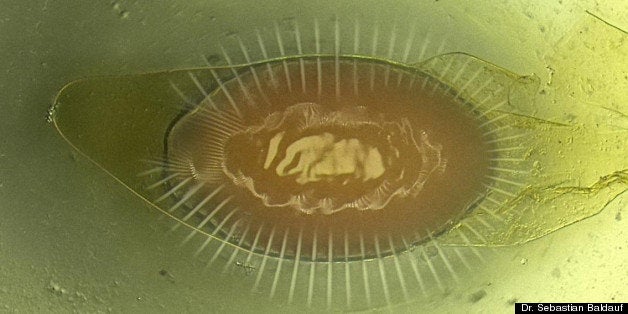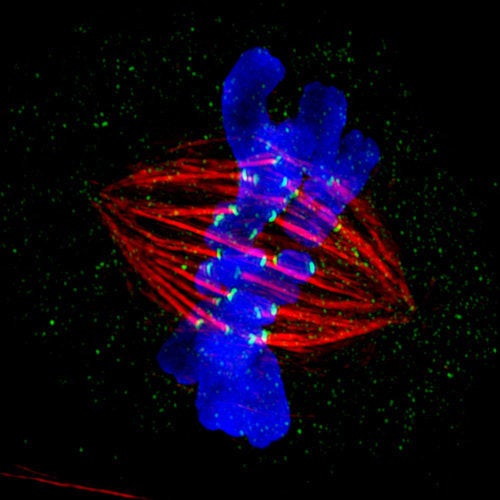By: Tanya Lewis, LiveScience Staff Writer
Published: 04/16/2013 11:12 AM EDT on LiveScience
A parasitic worm that latches onto the intestines of its hosts has inspired the development of a new surgical technique for skin grafts.
Some of the best engineering solutions come from nature. Researchers have designed a microneedle adhesive for skin grafts — a skin transplant used to treat wounds, burns or other injuries — based on the spiny-headed worm, Pomphorhynchus laevis. The new adhesive, described today (April 16) in the journal Nature Communications, is more than three times stronger than surgical staples, researchers say.
The worm attaches to its host's intestinal wall by skewering it with a sharp spine and then inflating its long, cactus-shaped head inside the tissue. Researchers mimicked this by developing a patch of tiny, cone-shaped needles with tips that swelled when exposed to water. [9 Creatures That Could Save Your Life]
"Drawing on how parasitic worms attach to and feed on fish, [the researchers] have designed a way to close surgical wounds that appears better than anything currently available for clinical use," Scott Somers, of the National Institutes of Health's National Institute of General Medical Sciences (NIGMS), said in a statement. NIGMS provided partial support for the research.
The water-based swelling mechanism is quick as well as reversible. The needles can pierce tissue with minimal force, keep continuous contact with the tissue and adhere strongly when the needles are swollen.
The needles can also stick to soft tissues without causing much damage, the researchers said. Removing the new adhesive, after the skin transplant "takes," causes less trauma to the tissue, blood and nerves than skin staples, and carries a smaller risk of infection, they added.
The new device might ultimately replace staples and sutures used by surgeons to secure skin grafts on patients with burns, infection, cancer and other serious conditions.
The needle system could also potentially be used to deliver wound-healing therapeutics. "These substances may be for example, antibiotics, growth-promoting compounds, or anti-inflammatory molecules," study author Bohdan Pomahac, director of plastic surgery and the burn center at Brigham and Women's Hospital, Boston, said in a statement.
Because the needles can adhere to wet tissues, they may be useful for a variety of surgical procedures inside the body, too.
Follow Tanya Lewis on Twitter and Google+. Follow us @livescience, Facebook & Google+. Original article on LiveScience.com.
Copyright 2013 LiveScience, a TechMediaNetwork company. All rights reserved. This material may not be published, broadcast, rewritten or redistributed.
Support HuffPost
Our 2024 Coverage Needs You
Your Loyalty Means The World To Us
At HuffPost, we believe that everyone needs high-quality journalism, but we understand that not everyone can afford to pay for expensive news subscriptions. That is why we are committed to providing deeply reported, carefully fact-checked news that is freely accessible to everyone.
Whether you come to HuffPost for updates on the 2024 presidential race, hard-hitting investigations into critical issues facing our country today, or trending stories that make you laugh, we appreciate you. The truth is, news costs money to produce, and we are proud that we have never put our stories behind an expensive paywall.
Would you join us to help keep our stories free for all? Your contribution of as little as $2 will go a long way.
Can't afford to donate? Support HuffPost by creating a free account and log in while you read.
As Americans head to the polls in 2024, the very future of our country is at stake. At HuffPost, we believe that a free press is critical to creating well-informed voters. That's why our journalism is free for everyone, even though other newsrooms retreat behind expensive paywalls.
Our journalists will continue to cover the twists and turns during this historic presidential election. With your help, we'll bring you hard-hitting investigations, well-researched analysis and timely takes you can't find elsewhere. Reporting in this current political climate is a responsibility we do not take lightly, and we thank you for your support.
Contribute as little as $2 to keep our news free for all.
Can't afford to donate? Support HuffPost by creating a free account and log in while you read.
Dear HuffPost Reader
Thank you for your past contribution to HuffPost. We are sincerely grateful for readers like you who help us ensure that we can keep our journalism free for everyone.
The stakes are high this year, and our 2024 coverage could use continued support. Would you consider becoming a regular HuffPost contributor?
Dear HuffPost Reader
Thank you for your past contribution to HuffPost. We are sincerely grateful for readers like you who help us ensure that we can keep our journalism free for everyone.
The stakes are high this year, and our 2024 coverage could use continued support. If circumstances have changed since you last contributed, we hope you’ll consider contributing to HuffPost once more.
Already contributed? Log in to hide these messages.

